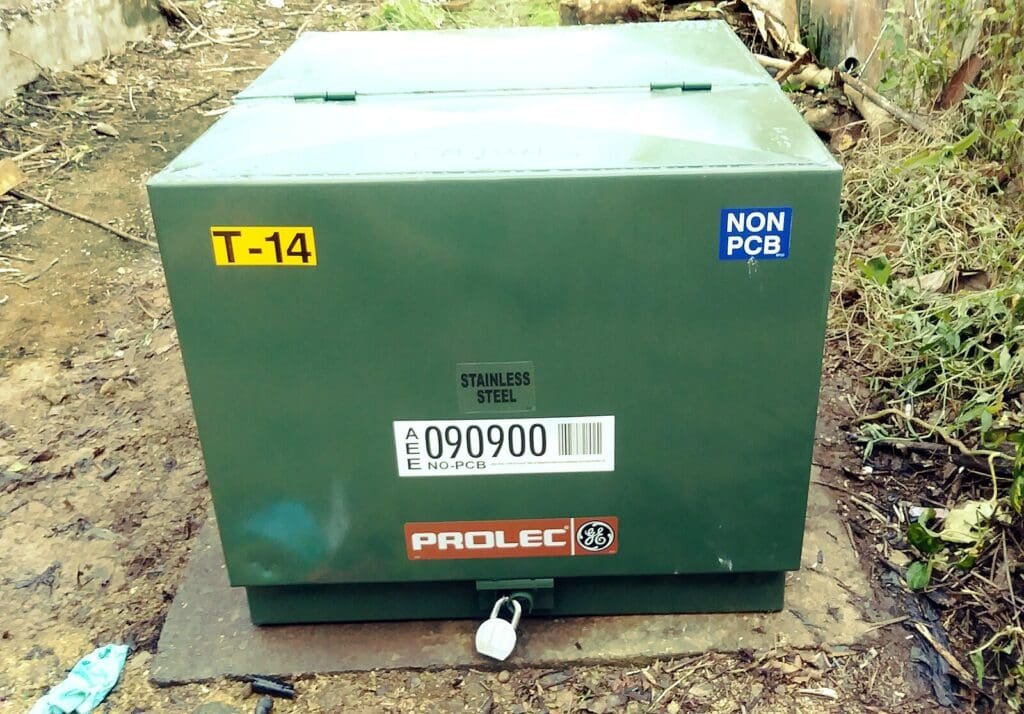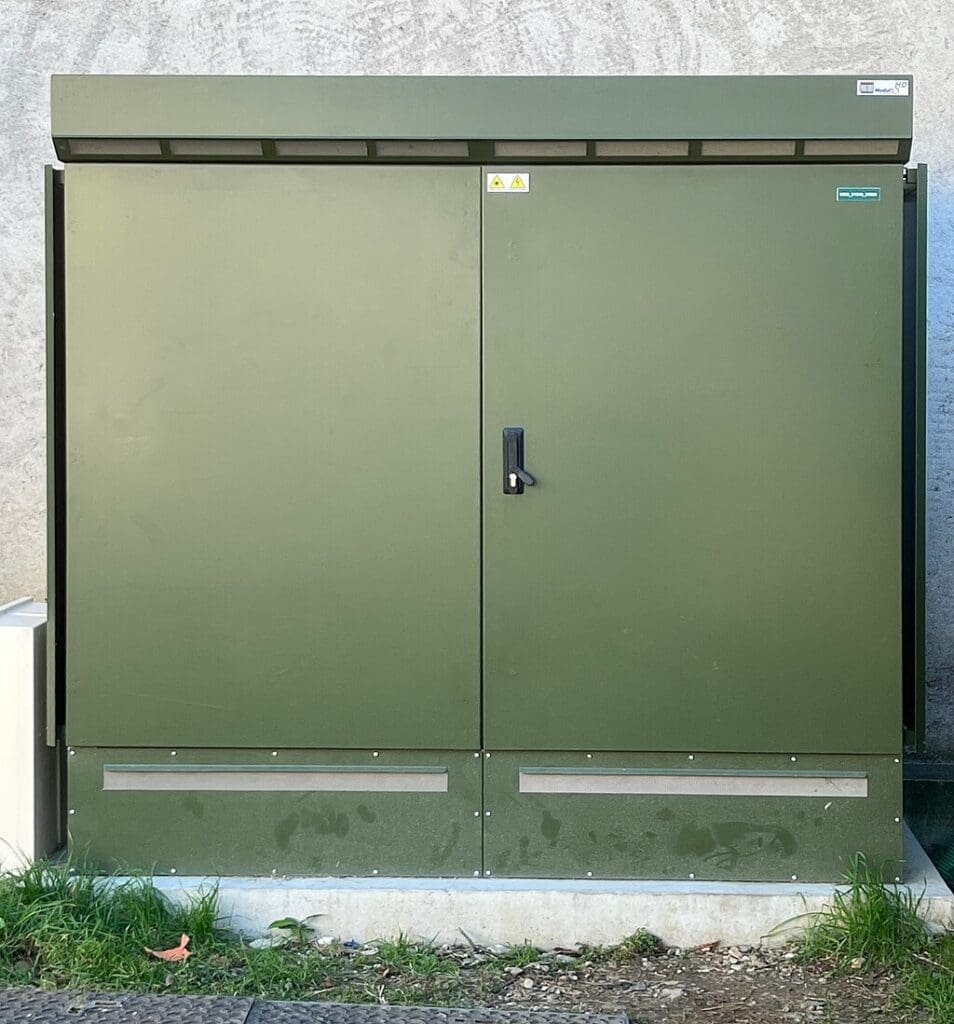An Introductory Look at the Pad Mounted Transformer
A pad mounted transformer, an essential element in the field of construction, is a type of electric power distribution transformer. It serves a critical role, stepping down high voltage current to a usable level, or vice versa.
This transformer type is encased in a locked steel cabinet, mounted on a concrete pad. Because of its placement on a concrete pad, it’s known as a ‘pad mounted’ transformer.
In construction settings, pad mounted transformers are commonly utilized to distribute power to housing complexes, shopping centers, and industrial premises. The secured shell allows these transformers to be strategically positioned in public places, demonstrating the balance between safety and function.
Let’s power up our knowledge and learn a bit more about pad mounted transformers.
Table of Contents
Understanding Construction Terms: What is a Pad-Mounted Transformer?

Definition of a Pad-Mounted Transformer
A pad-mounted transformer is an electrical transformer that is mounted on a concrete pad rather than being pole-mounted or placed inside a building. These transformers are typically used in urban and residential settings where overhead lines are not feasible or desirable.
Key Characteristics of Pad-Mounted Transformers:
- Designed for outdoor installation
- Enclosed in a weatherproof housing
- Equipped with high-voltage bushings for connection to overhead lines
- Provide voltage transformation for distribution to homes and businesses
Advantages of Pad-Mounted Transformers:
- Enhanced aesthetics as they can be installed closer to homes and buildings
- Reduced risk of power outages during inclement weather compared to overhead lines
- Easier maintenance access due to their ground-level installation
Applications of Pad-Mounted Transformers:
| Application | Benefits |
|---|---|
| Residential Areas | Provide reliable power distribution with minimal visual impact |
| Commercial Developments | Support efficient electricity supply for businesses |
| Industrial Facilities | Ensure stable power delivery for production processes |
Overall, pad-mounted transformers play a crucial role in electricity distribution in various settings, offering a reliable and efficient solution for power transformation and distribution.
A Comparative Look: Pole Mounted Transformers vs Pad-Mounted Transformers
Definition of Pole-Mounted Transformers
A pole-mounted transformer is another variant of an electrical transformer that is typically mounted on utility poles. This makes them ideal for rural settings or regions where space is not a limiting factor.
Key Features of Pole-Mounted Transformers:
- Installed above ground level
- Weatherproof design to withstand harsh environmental conditions
- Equipped with high-voltage bushings like pad-mounted transformers
- Transforms voltage for distribution to a smaller network of homes/businesses
Advantages of Pole-Mounted Transformers:
- Easier line repair due to the clear line of sight and access
- Potentially longer power-line reach given their height
- Adequately protected against ground-level environmental threats (flooding etc.)
Applications of Pole-Mounted Transformers:
| Application | Benefits |
|---|---|
| Rural Communities | Effective delivery of electricity in remote and low-density population areas |
| Highway Systems | Supports efficient power supply for lighting and signage |
| Agricultural Facilities | Stable electricity provision to power farming operations |
Comparing Pole-Mounted and Pad-Mounted Transformers
While both have the same basic function – to ensure the delivery of electrical power – there are distinct differences between pole-mounted and pad-mounted transformers. This includes everything from their physical placement and aesthetic, to the environments in which they’re best suited.
Key Differences Include:
- Placement: Pad-mounted transformers are ground-mounted and more suited to urban settings, while pole-mounted transformers are elevated and ideal for wider, rural areas.
- Aesthetics: Pole-mounted transformers are more visually obvious, while pad-mounted models can be better integrated into their surroundings.
- Accessibility: Pad-mounted transformers offer simpler access for maintenance, but pole-mounted models deliver potentially longer reach for power lines.
- Risk and Resilience: Pad-mounted transformers’ low-lying placement makes them less vulnerable to weather but more prone to ground-level hazards, whereas pole-mounted models have the opposite trade-off.
To summarize, understanding the differences between pad-mounted and pole-mounted transformers is necessary to effectively choose and install the right transformer for any given scenario. Both have their distinct advantages and applications, designed to meet the varying requirements of diverse settings in the world of power distribution.
Does Every House Have a Pad-Mounted Transformer?

Connection Between Houses and Transformers
Every house does not necessarily have a pad-mounted transformer.
It’s essential to note that houses usually connect to transformers shared among several homes, depending on the load requirement and area’s electrical grid design. This shared connective design is due to both economic and logistical reasons to efficiently manage and distribute power.
Factors Influencing the Use of Pad-Mounted Transformers:
- The residential area’s layout and geography
- Local regulations and codes
- The capacity and design of the local electrical grid
- Customer preferences pertaining to aesthetics and reliability
Safe Installation and Operation of Pad-Mounted Transformers
Installation Safety of Pad-Mounted Transformers
Installing pad-mounted transformers requires adhering to specific safety and technical standards. Professional electrical contractors normally undertake such installations because they require knowledge of electrical systems, safety practices, and local regulations.
Safety Measures To Be Followed:
- Ensuring proper distances from structures and combustible materials
- Installation on a suitably rated, stable, and flat pad
- Grounding the transformer properly to prevent electrical shock hazards
Operation Safety of Pad-Mounted Transformers
While pad-mounted transformers are designed to be safe for use in public spaces, it’s still crucial for everyone to know and adhere to safety guidelines to prevent accidents.
Safety Guidelines for Proper Operation:
- Maintaining safe distance from the transformer housing
- Not attempting to open the housing or tamper with the equipment
- Reporting any noticed issues to the local electrical utility
In conclusion, while pad-mounted transformers provide many benefits and have a broad range of applications, their use per household varies widely. Moreover, safe installation and operation should be strictly practised to ensure the safety and efficiency of these transformers.
Understanding an Additional Component: Substation Transformers
Definition of a Substation Transformer
A substation transformer occupies an intermediary role in power distribution, stepping down the voltage received from transmission lines to a level suitable for distribution lines. Unlike the pad-mounted transformers which service primarily residential or customer-specific needs, substation transformers are part of a network serving multiple customers.
Key Characteristics of Substation Transformers:
- Placed within fenced areas or dedicated buildings for safety
- Step down transmission voltages (115kV – 500kV) to distribution voltages (< 50kV)
- Enable long-range power transmission with acceptable losses
- Play a key role in both urban and rural electricity distribution networks
Advantages of Substation Transformers:
- Enable precise voltage control
- Facilitate effective long-distance power transmission
- Support the large-scale power distribution operations
Comparing Substation and Pad-Mounted Transformers
Key Differences Between Substation and Pad-Mounted Transformers
Both substation and pad-mounted transformers are crucial to electricity distribution infrastructure, but their roles, locations, and direct consumers differ. The differences pivot around their use-cases, power handling capabilities, and physical deployments.
Overlaying Differences:
- Capacity: Substation transformers handle a much higher power rating compared to pad-mounted transformers. They play an essential role in the primary distribution network.
- Function: Substation transformers step down high transmission voltages to medium distribution voltages, while pad-mounted transformers further reduce the voltage for direct consumer usage.
- Location: Substation transformers are typically housed in substations, which can be open air or enclosed spaces, whereas pad-mounted transformers are installed on concrete pads at ground level in the vicinity of the customers they service.
- User Level: Substation transformers feed into distribution lines which may eventually connect to several pad-mounted transformers. On the other hand, a pad-mounted transformer directly services final consumers or certain areas of a utility network.
Understanding the differences between substation and pad-mounted transformers accentuates the complexity of the power distribution system. Right from power generation to the final consumer, these transformers play unique roles making power distribution efficient and safe.
Choosing Between Substation, Pole-Mounted, and Pad-Mounted Transformers
Deciding the Appropriate Transformer
The choice of a transformer—whether it be substation, pole-mounted, or pad-mounted—depends on several factors involving both logistical and technical demands. Important considerations include the intended usage (residential, commercial, or industrial), the scale of power demands, spatial constraints, and local regulations.
Decision Influencing Factors:
- Power requirements: Larger power needs might necessitate substation transformers, while smaller, localized needs can be served by pad- or pole-mounted transformers.
- Local environment and regulations: Both aesthetic and regulatory norms can influence the choice.
- Geography: In urban settings, where space is limited, pad-mounted transformers may be ideal. Conversely, in rural areas with expansive distances, pole-mounted transformers may be more efficient.
The final decisions should always contemplate the broader grid infrastructure, energy efficiency, costs, and community concerns. Irrespective of the type, all transformers must accurately perform their crucial role of voltage regulation and energy distribution.
Putting A Wrap ON Pad Mounted Transformers
In conclusion, pad-mounted transformers serve as essential components in modern electricity distribution systems.
Their design for outdoor installation, weatherproof housing, and high-voltage connectivity to overhead lines make them versatile and practical for urban and residential environments. With advantages such as enhanced aesthetics, reduced outage risks, and easier maintenance access, these transformers provide reliable power distribution for homes, businesses, and industrial facilities.
By offering a stable power supply and efficient electricity distribution, pad-mounted transformers contribute significantly to the seamless functioning of diverse applications, ensuring continuous and dependable power delivery in various settings.






